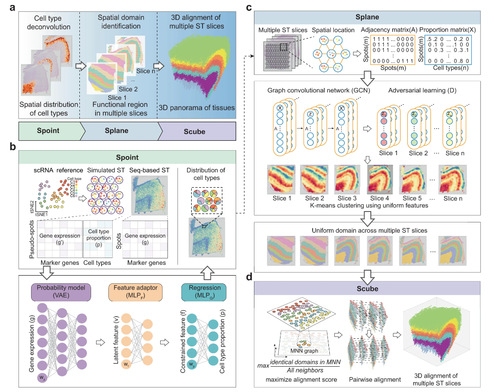USTC Develops a New Deep-learning-based Analysis Toolkit for Spatial Transcriptomics
Spatial transcriptomics (ST) technologies are applied in biology and medical research for its ability to detect the spatial distribution of transcriptome in histological tissue slices. By probing some of the transcripts or performing sequencing, the researchers are able to know about the transcription level in cells. Then they can further predict the cell types and build the three-dimensional (3D) structure of the tissue according to the information. However, the analysis could be difficult when there are multiple slices need to be analyze jointly using state of the art toolkits. It will bring challenge for researchers to manually assemble the slices and build the 3D structure.
To overcome the problem, a research team led by Prof. QU Kun from the University of Science and Technology (USTC) of Chinese Academy of Sciences (CAS) developed a new spatial architecture characterization by deep learning (SPACEL). Through three modules, Spoint, Splane and Scube, SPACEL can build the 3D panorama of tissues automatically.
Their research results were published in Nature Communications on Nov.22.

Workflow of SPACEL (Image by XU Hao)
The three modules are designed for three main task in ST analysis. Spoint can perform cell type deconvolution to predict spatial distribution of the cell-types A combination of simulated pseudo-spots, neural network modeling and statistical recovery of expression profiles ensure the robustness and accuracy of the prediction. Splane employs a graph convolutional network approach and an adversarial learning algorithm to identify special domains by jointly analyzing multiple ST slices. While Scube automatically align the slices and construct a stacked 3D architecture of the tissue. Through three modules, the 3D architecture of the tissue is built from the raw data.
Researchers applied SPACEL to 11 ST datasets, totaling 156 slices, and technologies like 10X Visium, STARmap, MERFISH, Stereo-seq, and Spatial Transcriptomics are involved during the process, SPACEL has demonstrated its superior performance over the others for cell type deconvolution in three core analytical tasks: predicting cell type distribution, identifying spatial domains, and reconstructing three-dimensional tissue structures.
The research provides a valuable integrated toolkit for ST data processing and analysis, benefiting further research employing ST technologies.
paper link:https://doi.org/10.1038/s41467-023-43220-3
(Written by WENG Gucheng, edited by HUANG Rui, USTC News Center)
Back
